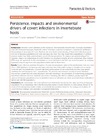Persistence, impacts and environmental drivers of covert infections in invertebrate hosts
dc.contributor.author
Fontes, Inês
dc.contributor.author
Hartikainen, Hanna
dc.contributor.author
Williams, Chris
dc.contributor.author
Okamura, Beth
dc.date.accessioned
2018-04-24T09:14:25Z
dc.date.available
2018-04-24T09:10:30Z
dc.date.available
2018-04-24T09:14:25Z
dc.date.issued
2017
dc.identifier.issn
1756-3305
dc.identifier.other
10.1186/s13071-017-2495-8
en_US
dc.identifier.uri
http://hdl.handle.net/20.500.11850/260102
dc.identifier.doi
10.3929/ethz-b-000207205
dc.description.abstract
Background
Persistent covert infections of the myxozoan, Tetracapsuloides bryosalmonae, in primary invertebrate hosts (the freshwater bryozoan, Fredericella sultana) have been proposed to represent a reservoir for proliferative kidney disease in secondary fish hosts. However, we have limited understanding of how covert infections persist and vary in bryozoan populations over time and space and how they may impact these populations. In addition, previous studies have likely underestimated covert infection prevalence. To improve our understanding of the dynamics, impacts and implications of covert infections we employed a highly sensitive polymerase chain reaction (PCR) assay and undertook the first investigation of covert infections in the field over an annual period by sampling bryozoans every 45 days from three populations within each of three rivers.
Results
Covert infections persisted throughout the year and prevalence varied within and between rivers, but were often > 50%. Variation in temperature and water chemistry were linked with changes in prevalence in a manner consistent with the maintenance of covert infections during periods of low productivity and thus poor growth conditions for both bryozoans and T. bryosalmonae. The presence and increased severity of covert infections reduced host growth but only when bryozoans were also investing in the production of overwintering propagules (statoblasts). However, because statoblast production is transitory, this effect is unlikely to greatly impact the capacity of bryozoan populations to act as persistent sources of infections and hence potential disease outbreaks in farmed and wild fish populations.
Conclusions
We demonstrate that covert infections are widespread and persist over space and time in bryozoan populations. To our knowledge, this is the first long-term study of covert infections in a field setting. Review of the results of this and previous studies enables us to identify key questions related to the ecology and evolution of covert infection strategies and associated host-parasite interactions.
en_US
dc.format
application/pdf
en_US
dc.language.iso
en
en_US
dc.publisher
BioMed Central
en_US
dc.rights.uri
http://creativecommons.org/licenses/by/4.0/
dc.subject
Tetracapsuloides bryosalmonae
en_US
dc.subject
Fredericella sultana
en_US
dc.subject
Proliferative kidney disease
en_US
dc.subject
Myxozoans
en_US
dc.subject
Bryozoans
en_US
dc.subject
Productivity
en_US
dc.subject
Temperature
en_US
dc.subject
Host condition-dependent effects
en_US
dc.subject
Covert infection strategies
en_US
dc.subject
Fish disease reservoirs
en_US
dc.title
Persistence, impacts and environmental drivers of covert infections in invertebrate hosts
en_US
dc.type
Journal Article
dc.rights.license
Creative Commons Attribution 4.0 International
dc.date.published
2017-11-02
ethz.journal.title
Parasites & Vectors
ethz.journal.volume
10
en_US
ethz.journal.issue
1
en_US
ethz.journal.abbreviated
Parasit. vectors
ethz.pages.start
542
en_US
ethz.size
15 p.
en_US
ethz.version.deposit
publishedVersion
en_US
ethz.identifier.wos
ethz.identifier.scopus
ethz.publication.place
London
en_US
ethz.publication.status
published
en_US
ethz.leitzahl
ETH Zürich::00002 - ETH Zürich::00012 - Lehre und Forschung::00007 - Departemente::02350 - Dep. Umweltsystemwissenschaften / Dep. of Environmental Systems Science::02720 - Institut für Integrative Biologie / Institute of Integrative Biology::03705 - Jokela, Jukka / Jokela, Jukka
en_US
ethz.leitzahl.certified
ETH Zürich::00002 - ETH Zürich::00012 - Lehre und Forschung::00007 - Departemente::02350 - Dep. Umweltsystemwissenschaften / Dep. of Environmental Systems Science::02720 - Institut für Integrative Biologie / Institute of Integrative Biology::03705 - Jokela, Jukka / Jokela, Jukka
ethz.date.deposited
2017-11-12T04:07:16Z
ethz.source
SCOPUS
ethz.source
BATCH
ethz.eth
yes
en_US
ethz.availability
Open access
en_US
ethz.rosetta.installDate
2018-04-24T09:10:34Z
ethz.rosetta.lastUpdated
2020-02-15T12:29:48Z
ethz.rosetta.versionExported
true
dc.identifier.olduri
http://hdl.handle.net/20.500.11850/207205
dc.identifier.olduri
http://hdl.handle.net/20.500.11850/233110
ethz.COinS
ctx_ver=Z39.88-2004&rft_val_fmt=info:ofi/fmt:kev:mtx:journal&rft.atitle=Persistence,%20impacts%20and%20environmental%20drivers%20of%20covert%20infections%20in%20invertebrate%20hosts&rft.jtitle=Parasites%20&%20Vectors&rft.date=2017&rft.volume=10&rft.issue=1&rft.spage=542&rft.issn=1756-3305&rft.au=Fontes,%20In%C3%AAs&Hartikainen,%20Hanna&Williams,%20Chris&Okamura,%20Beth&rft.genre=article&rft_id=info:doi/10.1186/s13071-017-2495-8&
Files in this item
Publication type
-
Journal Article [128916]

